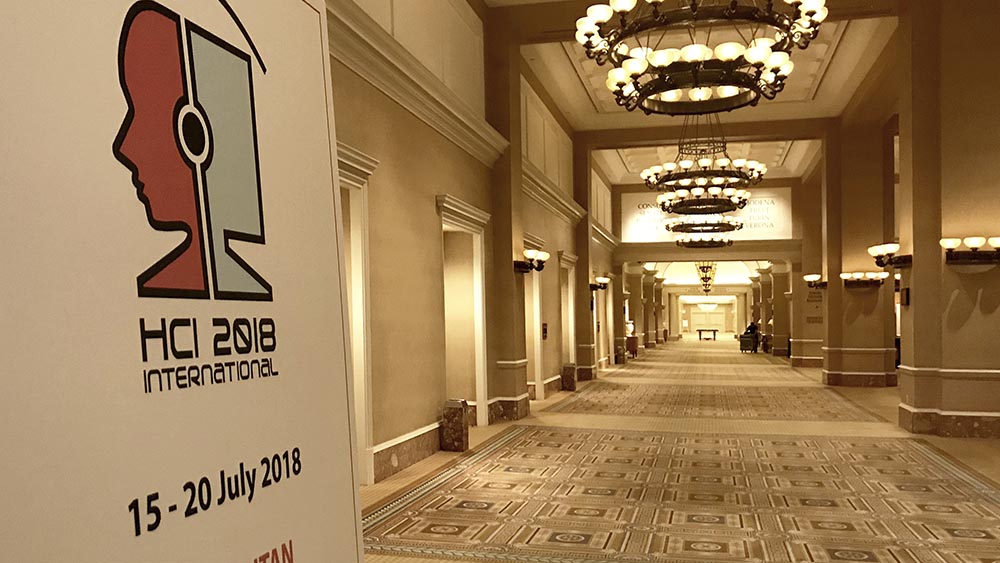Auf meiner letzten Dienstreise für die SAP verschlug es mich ins fabulöse Las Vegas - nicht nur, um die Wüstenstadt mitten im Juli zu erleben, sondern, viel wichtiger, um unsere neueste Innovation auf der diesjährigen Human-Computer-Interaction-Konferenz zu präsentieren.
Eine große Konferenz
Noch nie zuvor hatte ich eine Konferenz besucht, die eine so große Zahl an Themen und Vorträgen abdeckte - und zusätzlich zu den etwa 350 Paper-Präsentationen (von den insgesamt 1100+ veröffentlichten Papers) wurden mehr als 20 Halbtages-Tutorials angeboten und über 200 Poster ausgestellt. 1700 Teilnehmer aus 74 Ländern waren zu Besuch, und das Konferenzprogramm selbst umfing fast 100 Seiten.
Entsprechend schwierig war es, sich selbst durch den jeweiligen Konferenztag zu organisieren. Und das lag auch nicht ausschließlich am Inhalt selbst - auch der Veranstaltungsort an sich war riesig, und die Distanz vom Hotelzimmer im Caesars Palace durch Kasinos, Essen- und Einkaufsbereiche bis hin zum Konferenzcenter (im gleichen Hotel!) betrug nahezu 1km.
Mit ihren 14 angeschlossenen Konferenzen (wie zum Beispiel 10th International Conference on Cross-Cultural Design; 7th International Conference on Design, User Experience and Usability; 5th International Conference on Learning and Collaboration Techniques), schien die HCII mehr auf die wissenschaftliche (weniger die pragmatische) Seite von UX zu beleuchten. Im Unterschied zu Konferenzen wie Interaction oder M&C, fehlten zentral organisierte Netzwerk-Events (außer natürlich das Willkommens-Dinner). Die Qualität der Präsentationen reichte von sehr schwer zu folgen oder keine Relevanz bis hin zu großartige Einsichten und humorvolle Wissenschaft. [ab hier geht's nur auf Englisch weiter - über ein paar Inhalte der HCII].

“Technology in Support of Healthy Habits”
The conference’s opening key note speech was held by Microsoft’s Mary Czerwinsky, a principal researcher and research manager, who spoke about affective computing, wearable-free sensing, conversational UIs, and the importance of attractiveness vs. reliability of chatbots. Already today, enough usage data is being captured for companies being able to draw conclusions about their users’ state of minds and emotions – by systematically evaluating text semantics, tone of voice, facial expressions, or even the way you type. According to Czerwinsky, the goal is to create digital agents that you want to use, because they know you and thus are able to help you. It’s not about a chatbot pretending to be human, but a digital agent reacting in a human way.
She continued to present a couple of case studies; starting with ParentGuardian, which provides parents small hints on how to behave in specific situations with ADHD children, while measuring the parents’ stress-factor using smart bracelets. Another example was Chewie; an app which predicts about-to-eat moments for just in time eating intervention. By combining the ability to identify behavioural patterns with the development of trustworthy, reliable, and attractive conversational user interfaces, even agent-based psychological interventions can and will be created.
Fitness, Health and Wearables
One of the personally relevant tracks for me I found on Wednesday – within Social Computing and Social Media I discovered a couple of sessions specifically focusing on activity trackers in the everyday life – seen from a rather scientific perspective. It started with a comparison of different fitness tracking reward programs in Germany and Australia, giving an outlook about how health insurances might motivate us in sharing even more data with them. Another presentation shared insights on data privacy of fitness trackers, whereas the third presenter talked about the relationship between people’s activity levels and their network sizes: the more followers you have the more likely you are to repeat exercising. The last of this track’s presentation discussed reasons why users join fitness communities on Facebook.
Presenting EUREKA
The main reason, though, for my trip to HCII Las Vegas was presenting EUREKA, based on a paper my colleague Panos and I submitted a couple months back. EUREKA stands for “Engineering Usability Research Empirical Knowledge and Artifacts” and summarises a methodology and tool that facilitates a structured yet flexible iterative process to qualitative data analysis. Based on the fact that collecting, analysing, sorting, and making sense of the data collected during a usability test study is a time-consuming task that requires a lot of effort, we studied on one hand a methodological perspective to usability tests data analysis and on the other hand created a tool that could provide the features and functionalities to realise this method, in various situations, scenarios and projects. Currently, EUREKA is available as a functional Excel prototype, consisting of five distinctive modules, allowing users to step-by-step analysing their qualitative and quantitative test data, prioritising findings, finding, evaluating and tracking their solutions.
The method itself is based on principles of theoretical directions, like Kolb’s Experiential Learning Theory whereby knowledge is a result of a transformational experience and Engeström’s Activity Theory – Learning by Expanding, that the activity (i.e., data analysis) itself constitutes the medium for learning and development, through active collaboration, reflection and contradiction. Therefor, EUREKA was presented within the track of “Learning and Collaboration Technologies”. For a closer look to the idea of EUREKA, please have a look at the video above. A more detailed description will be published at SAP UX Community Blog in September 2018, please find the link below.
What else?
If you want to know more, please feel free to refer to a couple of resources:
EUREKA Conference Paper
Germanakos P. & Fichte L. (2018). “EUREKA: Engineering Usability Research Empirical Knowledge and Artifacts – An Experience-based Expansive Learning Approach”, Proceedings of the 20th International Conference on Human-Computer Interaction (HCI 2018), Las Vegas, Nevada, July 15-20, 2018, Lecture Notes in Computer Science 10924, Springer, pp. 85-103
EUREKA Conference Presentation Slides
SAP UX community [EUREKA article to be published in September]

